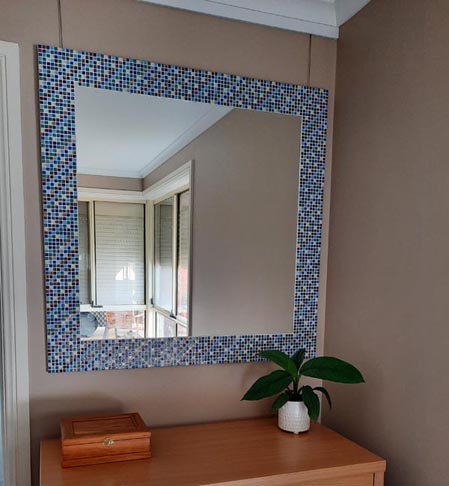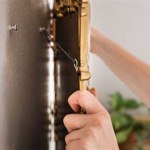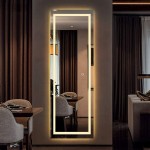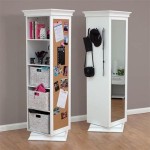How To Hang A Heavy Mirror On Plaster Wall
Hanging a heavy mirror on a plaster wall presents a unique set of challenges compared to drywall. Plaster, while offering a more durable and aesthetically pleasing surface, is also more brittle and prone to cracking if not handled properly. Therefore, careful planning and the use of appropriate hardware are essential to ensure the mirror hangs securely and without causing damage to the wall. This article provides a comprehensive guide on how to safely and effectively hang a heavy mirror on a plaster wall.
Before commencing the hanging process, several factors must be considered. These include the weight of the mirror, the type and condition of the plaster wall, and the appropriate hanging hardware required. Thoroughly assessing these factors will contribute significantly to a successful and damage-free installation.
First, accurately determine the weight of the mirror. This information is crucial for selecting the appropriate hanging hardware. Mirrors often have their weight listed on the packaging or on the back of the mirror itself. If the weight is not readily available, it can be estimated by multiplying the mirror's surface area (in square feet) by a factor ranging from 3 to 5 pounds per square foot, depending on the thickness of the glass and the weight of the frame. It is always advisable to err on the side of caution and overestimate the weight to ensure a secure hold.
Second, evaluate the condition of the plaster wall. Look for any signs of cracks, crumbling, or water damage. These issues can compromise the wall's structural integrity and make it difficult to achieve a secure anchor. If such problems are present, they should be addressed before attempting to hang the mirror. Minor cracks can sometimes be repaired with patching compound, but more extensive damage may require professional repair.
Third, identify the type of plaster wall you are working with. There are primarily two types: lath and plaster, and plasterboard (also known as gypsum board with a thin plaster skim coat). Lath and plaster walls are typically older and consist of wooden strips (lath) covered with multiple layers of plaster. Plasterboard walls are more common in newer homes and consist of sheetrock with a thin layer of plaster applied on top for a smooth finish. Determining the wall type is essential for selecting the correct anchoring method. A stud finder may be helpful in locating the underlying studs, which provide the strongest support.
Key point 1: Selecting the Right Hanging Hardware
The selection of appropriate hanging hardware is paramount to the success and safety of mounting a heavy mirror. The hardware must be capable of supporting the mirror's weight and designed to work effectively with the specific type of plaster wall. There are several options available, each with its own advantages and disadvantages.
One option is to use heavy-duty picture hooks designed for plaster walls. These hooks typically have multiple small nails that distribute the weight across a larger area of the plaster, minimizing the risk of cracking. However, their weight capacity is usually limited, making them unsuitable for very heavy mirrors. It is imperative to check the weight rating of the hooks to ensure they can adequately support the mirror's weight with a safety margin.
Another option is to use plaster screws or anchors. These anchors are designed to grip the plaster and provide a secure hold. Toggle bolts are a particularly strong type of anchor that are well-suited for heavy mirrors. They consist of a bolt with a hinged "toggle" that expands behind the wall, providing a large bearing surface. When installing toggle bolts, a hole must be drilled through the plaster, allowing the toggle to be inserted. Once the toggle is behind the wall, it expands as the bolt is tightened, creating a secure anchor. It's essential to use a drill bit specifically designed for plaster to prevent chipping and cracking.
A third option is to locate and utilize wall studs. Wall studs are vertical framing members that provide the strongest support for hanging heavy objects. Using a stud finder, locate the studs in the area where the mirror is to be hung. Once a stud is located, drive screws directly into the stud. This method provides the most secure hold, but it may require repositioning the mirror slightly to align with the stud's location. If you can hit two studs with the mirror's hanging hardware, this is the best option.
When selecting hardware, consider the mirror's hanging mechanism. Some mirrors have D-rings or wire hangers, while others have metal brackets. Ensure that the chosen hardware is compatible with the mirror's hanging mechanism. For D-rings, use sturdy hooks or screws with a wide head. For wire hangers, use heavy-duty picture wire and secure it to the hardware with a tight knot.
Key point 2: Preparing the Wall and Mirror
Proper preparation of both the wall and the mirror is crucial for a successful and secure installation. This involves taking accurate measurements, marking the desired location, and preparing the hanging hardware on the mirror.
First, determine the desired location for the mirror. Use a level and a measuring tape to ensure that the mirror is hung straight and at the correct height. Mark the location of the top of the mirror on the wall using a pencil. Then, measure the distance from the top of the mirror to the hanging hardware (D-rings, wire, or brackets) on the back of the mirror. Subtract this distance from the marked location on the wall to determine the exact location for the hanging hardware on the wall.
Use a level to ensure that the marked locations are straight. This is especially important if using multiple hanging points. If using studs, locate them with a stud finder and mark their location on the wall. Ensure that the marked locations align with the studs.
Before drilling or hammering into the plaster wall, it is advisable to apply painter's tape to the area. This will help to prevent the plaster from chipping or cracking during the drilling or hammering process. Position the tape over the marked locations and smooth it down securely.
Inspect the hanging hardware on the back of the mirror. Ensure that it is securely attached and in good condition. If using wire, make sure it is strong enough to support the mirror's weight. If using D-rings, ensure that they are securely fastened to the mirror's frame. Replace any damaged or worn hardware before proceeding.
Consider using felt pads on the back of the mirror to protect the wall from scratches and to prevent the mirror from shifting. Attach the felt pads to the corners of the mirror's frame before hanging it.
Key point 3: Hanging the Mirror Safely and Securely
The final step involves hanging the mirror on the wall. This requires careful execution to avoid damaging the wall or the mirror. It is recommended to have a helper assist with this step, especially for larger and heavier mirrors.
If using picture hooks, align the hooks with the marked locations on the wall and gently hammer them into the plaster at a slight downward angle. Be careful not to hit the hooks too hard, as this can cause the plaster to crack. If using plaster screws or anchors, drill pilot holes at the marked locations using a drill bit specifically designed for plaster. The pilot holes should be slightly smaller than the diameter of the screws or anchors. Insert the screws or anchors into the pilot holes and tighten them until they are snug but not overtightened. Over-tightening can damage the plaster and compromise the hold.
If using toggle bolts, drill holes large enough to accommodate the toggle wings. Fold the toggle wings and insert them through the holes. Once the toggle wings are behind the wall, they will spring open. Tighten the bolts until the toggle wings are firmly pressed against the back of the wall. Do not overtighten the bolts, as this can damage the plaster.
If using studs, drill pilot holes into the studs at the marked locations. Use screws that are long enough to penetrate the stud by at least 1 inch. Drive the screws into the studs until they are snug but not overtightened.
With the hanging hardware securely installed, carefully lift the mirror and align it with the hardware. Gently lower the mirror onto the hooks or screws, ensuring that the hanging mechanism is securely engaged. If using wire, carefully drape the wire over the hooks. If using D-rings, align the D-rings with the screws or hooks and lower the mirror into place.
Once the mirror is hanging, use a level to ensure that it is straight. If necessary, make minor adjustments to the hanging hardware to level the mirror. To test the stability of the mirror, gently push on it to ensure that it is securely attached to the wall.
Clean up any debris or dust created during the hanging process. Remove the painter's tape from the wall and dispose of it properly. Inspect the wall for any signs of damage or cracking. If any cracks are present, repair them with patching compound.
Regularly inspect the mirror's hanging hardware to ensure that it remains secure. Over time, the hardware may loosen or wear down. If any issues are detected, replace the hardware immediately to prevent the mirror from falling.
By following these steps and using appropriate hardware, you can safely and effectively hang a heavy mirror on a plaster wall without causing damage. Remember to prioritize safety and to seek professional assistance if you are unsure about any aspect of the process.
:strip_icc()/ScreenShot2022-04-28at1.12.19PM-e055476c70c6438585fa7c5cd531edcf.png?strip=all)
4 Easy Ways To Hang A Heavy Mirror

How To Hang A Very Heavy Picture Or Mirror The Best

A Better Way To Hang Heavy Mirror Hanging Pictures
Hanging Heavy Framed Mirrors Lath Plaster Walls The Picture Framers Grumble

How To Hang A Large Or Heavy Mirror

How To Hang A Heavy Picture On Plasterboard Wall

How To Hang A Heavy Mirror

How To Hang A Heavy Mirror On Drywall Stas Picture Hanging Systems

How To Hang A Heavy Mirror She Holds Dearly

How To Hang A Heavy Mirror








